| |
|
 |
|
This parish church was
originally St
Mary's chapel, an outpost of All Saints,
half a mile away at Little Wenham. But
the mother church now sits silent and
alone out in the fields, and St Mary is
at the heart of one of Suffolk's biggest,
busiest villages with more than 3,000
people. Which just goes to show, I
suppose, how times change, and how some
things remain. This village has no
connection with Capel St Andrew, 20 miles
away in the marshes. When Suffolk people
say Capel, they mean this one. Mortlock found the core of a
Norman church here; but, as he says,
pretty much all that remains on view is
the result of the successive 14th and
15th century rebuildings, making this a
grand Perpendicular affair, with
Decorated chancel. The church sits above
the busy road through the village, and it
has cut down over the centuries to leave
the church high on a bank above it.
However, the uneven churchyard suggests
that this may also be the result of
imported earth to renew burial grounds,
something often attributed to hilltop
churches, but actually quite rarely
found.
St Mary was high in
another way, for this was one of the
county's Anglo-catholic shrines. Suffolk
is a notoriously Low Church county, but
here is a faith community which
successfully combined High Church
tradition with its role as a centre of
Parish life, sacred and profane.
|
The church is open every
day. And so, you step inside to a devotional
interior. It was clearly much revamped by the
Victorians, but has been beautified tenderly
since. The west end of the south aisle was
cleared to create a wide open baptistery around
the font. There is a feeling of light from the
great 15th century windows, and of colour from
the devotional art that graces the building. The
best of these is the window by FC Eden at the
east end of the same aisle. It depicts the
Blessed Virgin and child flanked by St Edmund and
St Felix, and must count among his best work in
the county.
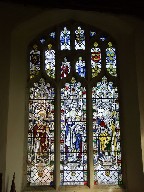
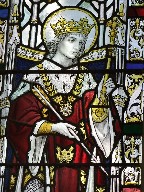 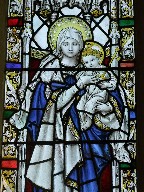 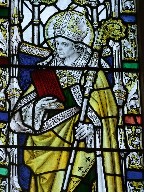
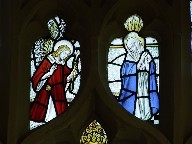 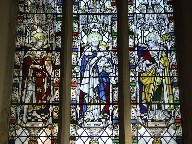 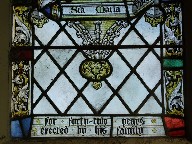
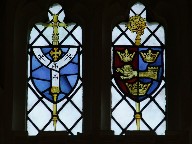
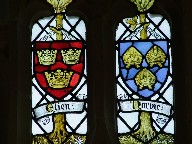
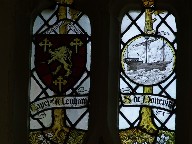
The other great star here
is the reredos. It is 19th Century, but came from
a Belgian church, and has echoes of Flemish
tradition. The glass above of the four archangels
adds to the sense of gravitas. The statues are
colourful without being garish, accentuated by
the simplicity of the rural ambience. It all
provides an interesting comparison with nearby
Stratford St Mary, showing that it was possible
for the Victorians to resacramentalise a medieval
interior without making it anonymous.
Roy Tricker, in his
fascinating Suffolk Churches Ancient and
Modern, records the successive waves of
Anglo-catholic enthusiasm that created this
treasure house. The Parish priest for more than
forty years from the 1870s was a Father Johnson.
His are the angels in the chancel roof, the rood
beam and rood with attendant figures, all of
which were carved in Oberammergau. He also bought
and installed the reredos; when he died, the
south aisle was converted into the Chapel of St
Edmund in his memory and the Eden glass
installed.
| Father Johnson had
also owned a set of Stations of the
Cross, but he had not been brave or
foolish enough to install them in the
church, preparing instead an oratory in
the Vicarage. They had an exceptionally
fascinating history for Suffolk
Anglo-catholic watchers, for they were
the very same Stations that had been in
the controversial Convent at Claydon in
the 1850s. This Convent, under the
pastoral oversight of the remarkable
George Drury, was on more than one
occasion attacked by a mob of furious
protestants; you can read more about it
on the entries for Claydon and Akenham. His successor, Father
Robertson, seeing that the time was
right, moved the Stations into the
church, where their pedigree added a
frisson to their 19th Century
sentimentalism. Later, they were replaced
with those in the church today by Father
Denis Pearce. I wonder what happened to
them.
|
|
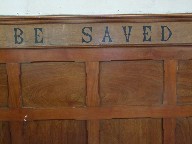 |
|
|
|

